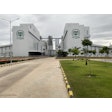
The Indian animal feed sector is steadily developing amid growing domestic livestock and poultry production, which contribute to stable domestic demand for animal feed among local farmers.
According to a recent report in the Indian Economic Times, the revenue of the Indian poultry sector will grow 10% this year, as the industry shows generally good results, primarily in terms of output. At the same time, almost a similar situation is observed in livestock segment, which is also seeing its share of the Indian agriculture gross domestic product (GDP) grow. It contributes 4.11% of the Indian total GDP and 25.6% of total agriculture GDP of the country.
The ongoing growth of major consuming industries creates conditions for a further development of animal feed industry of India, although several problems continue to prevent its more active growth.
Probably the biggest of them is related to the shortage of fodder in the country. This has been recently confirmed by the Indian Union Minister of Fisheries, Animal Husbandry and Dairying Parshottam Rupala, who said the industry and the national government "should take serious steps" to address this problem.
India traditionally faces a shortage of fodder in the range of 20% to 25% from its overall annual needs, which is mainly due to seasonal and regional factors. However, this year these figures are significantly higher due to shrinking land resources of the country. Due to this, the government plans to take measures to expand the areas of grazing lands and to ensure their more sustainable and careful use.
According to experts of the Trade Promotion Council of India (TPCI), India’s trade and investment promotion organization, fodder is being cultivated on 8.4 million hectares (nearly 4% of gross cropped area). Some local analysts expect that, without action from the state, these areas will be further reduced due to climatic and other issues within the next several years, which will put additional pressure on the industry and significantly slow down its further growth rates.
 Amul's state-of-the-art feed manufacturing plant at Kapadwanj Tuluka in Kheda, Gujarat, India's largest cattle feed plant.Courtesy Shreeganesh Corp.
Amul's state-of-the-art feed manufacturing plant at Kapadwanj Tuluka in Kheda, Gujarat, India's largest cattle feed plant.Courtesy Shreeganesh Corp.
Raw material volatility
In the meantime, in addition to fodder shortage, in the last two to three years the country’s poultry and livestock industry had to deal with unprecedented rise in the price of key feed material, corn and soymeal. Due to this, representatives of local farmers have called on the state to liberalize trade policy and to allow more imports of essential ingredients for their needs from abroad.
In general, an active development of India's feed sector began during the 1960s with the establishment of several facilities, primarily small and medium-sized, in different parts of the country and mainly its northern and western parts. The industry is characterized by a low level of concentration and saturation, being primarily dominated by small and medium producers.
Feed production continues to grow
Despite the existing problems after the end of the pandemic, the development of the industry has been carrying out at generally good growth rates.
This is confirmed by statistics. According to a recent report of the research agency IMARC Group, the Indian feed market grew at 3.5% annually over the past five years and the size reached INR956.7 billion in 2022 (US$11.47 billion). According to analysts’ predictions, the market may reach US$19.23 billion by 2028, if it maintains its annual growth rates in the range of 5% to 7% within the next five years. South India is a center of animal feed production in India, accounting for the largest market share. In recent years, the biggest growth of output was observed in Andhra Pradesh, Karnataka and Tamil Nadu, which became mainly due to the rise in the manufacturing of poultry products.
In terms of market structure, most of the market accounted for the segments of poultry and cattle feed, the major consumers of animal feed in India.
As for cattle feed, it mainly comprises grains (such as sorghum and millet) and their cakes, mustard, cotton seeds and their oil cakes, de-oiled rice and soybean. On the other hand, poultry is mainly fed corn, sorghum, wheat, soy and their concentrates.
 Indian Union Minister of Fisheries, Animal Husbandry and Dairying Parshottam Rupala, a state official, responsible for development of the animal feed sector in the Indian government.PTI
Indian Union Minister of Fisheries, Animal Husbandry and Dairying Parshottam Rupala, a state official, responsible for development of the animal feed sector in the Indian government.PTI
Animal protein demand
Amid the growing Indian broiler and egg sectors (India saw production of 120.6 billion eggs in fiscal year 2021-22), most analysts expect a significant increase of poultry production in the country. That will contribute to an increase in demand for poultry feed. This is also confirmed by predictions of local analysts, who say the poultry sector is projected to grow in the next five years at a CAGR of more than 8% to reach US$35 billion by 2028.
At the same time, the growth of demand will be observed from the country’s cattle sector, given the status of India as the largest milk producer in the world, contributing 24% of global milk production in 2021-22. Of these, Western India has been registering the maximum share in cattle feed production followed by the north, south and east.
As the majority of other emerging nations, India in recent years has faced less availability of raw materials for domestic animal feed sector, which forced local manufacturers to shift to other materials along with conventional sources.
Among these are some nutrient-rich additives, as well as byproducts of the ethanol industry, i.e dried distillers grains (DDGs), which is actively being utilized in animal feed sector — already accounting for 7% to 10% in overall structure of consumption.
Government involvement
The Indian government is aware of the existing problems, planning to create conditions for the increase of output of some important raw materials and ingredients for the needs of the industry, such as corn.
Despite the fact that, globally, corn is the primary feedstock for ethanol production, it is used in India mostly for animal feed.
According to a spokesman for the Indian Ministry of Agriculture, the government will promote corn production by developing high-yielding varieties. It is expected most future output will be sent for the needs of the country’s animal feed sector.
As the Indian agriculture secretary Manoj Ahuja has recently said, corn production in the country needs to be increased by 10 million tons over the next five years to meet growing demand for poultry feed.
There were some rumors at the end of 2022 about plans of the state to impose a ban on corn exports from the country in order to stabilize domestic prices, however, no final decision regarding with this issue was taken.
















